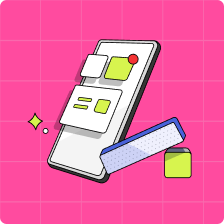Shopping online is easier than ever. With just a click of a mouse, you can buy anything from clothing to the latest video game—all from the comfort of your home. While shopping online has its perks, it’s important to shop smart.
Here are some tips to help you protect yourself while shopping online.
What are the risks of buying items online?
Phishing
Phishing is a cyber attack that uses an email or text message to get personal or sensitive information from the person they are targeting. Unfortunately, phishing is the third most common scam in Canada. That’s why it’s important to understand what phishing is. A phishing scam could look like an email from your bank, or a random text message. Some of the signs of a phishing scam include grammer errors, misspelled words, incorrect email address, or a message that sounds urgent.
Theft of data
Shopping online usually requires us to provide personal information, such as our full name, home address, and a credit card number or other method of payment (like the Mydoh Smart Cash Card). It’s important to understand that theft of data and identity theft could occur online. You may be vulnerable to having your personal information stolen by cybercriminals who could hack into their account or commit other fraudulent activities, such as opening a credit card in your name.
Malware
If you spend more much time on your laptop as they do studying, you probably don’t need to lecture them about the dangers of malware. But for the rest of us, malware is a catch-all phrase for malicious software, such as viruses, worms, or ransomware. Malware is designed to harm a person’s device or network. Typically, cybercriminals use malware to obtain personal information which they can use for financial gain.
Fake online reviews
How many of us check the reviews before buying an item online? When there are near-identical items to choose from, that five star rating could be the deciding factor before clicking “add to shopping basket.” But, according to a 2017 report, approximately one-third of all online consumer reviews are fake. Be aware that some companies may encourage people to post favourable reviews online.
Counterfeit goods
As shopping online has become more popular, so have counterfeit goods in Canada. Be warned: those top-dollar designer sneakers may be a knock-off. The Canadian Anti-Counterfeiting Network reports that between $20 and $30 billion in counterfeit products move through Canada every year. That’s a lot of fake products.

How can you protect yourself when shopping online?
Here are some tips to help protect you when shopping online:
Purchase from trusted and secure sites
Shoop at trusted sites, which means sites where the URL begins with “HTTPS.” You should also look for a locked padlock on any site before shipping The icon usually appears on the left of the URL in the address bar.
You should also be wary of sites that may look similar to trusted sites, but the URL is slightly different (for example amazon.net instead of amazon.ca), as these sites could be fake. Another red flag might be websites with typos or grammatical errors. Consider checking to see if the website has a phone number and physical address before spending your money online.
Protect your personal information
You may not realize how much of your personal information you’re unknowingly sharing online. Thanks to social media, casual acquaintances can know your birthday and even where you live. Remember to not overshare details on social media sites or other places online. Similarly, if they’re shopping online and are asked questions about personal details such as financial data, they should consider the following:
- Is this information necessary for my online purchase?
- Who is collecting this information?
- What will they do with it?
Be wary of great deals
We all love a bargain, but if you come across an online deal that’s too good to be true, chances are it probably is. If an item is priced much lower than it normally is, it could mean the item is counterfeit or the website isn’t legitimate. Fake e-commerce sites are becoming increasingly common. To help mitigate the risk, check out reviews of the site from multiple sources.
Create strong passwords
More than a few of us are guilty of using the same password without changing it frequently (if at all). But, in order to help protect yourself when shopping online, you should create a unique password—one that avoids using personal details like a pet’s name. There are plenty of password generators available online that will help you create a password that’s tougher to crack. Create a unique password for each website, rather than recycling the same password for every online shopping site.
Check your financial statements
While there are steps you can take to shop online safely, it’s also a good idea to check your bank statements after purchasing items online. Mydoh makes it easy to track your spending – log in to the app and check your purchases under “spend.”
What should you do if they think they’ve been scammed online?
If you think you’ve been scammed online and you paid by credit card, you may be able to dispute the charges with the credit card company. Depending on the financial institution, credit card users typically have between 30 to 60 days to do so. Your parents can also help you report fraudulent or suspicious activity to the Canadian Anti-Fraud Centre (CAFC) through their website or by calling 1-888-495-8501. If you think you’ve been scammed, be sure to change your passwords.
How can you keep yourself safe online?
Whether it’s your first time or 50th time online shopping, here are some things to consider before adding an item to your shopping cart:
- Look for the security symbol, such as a key or padlock, on the website
- Create strong, unique passwords when buying online
- Question “too good to be true” deals
- Research reviews of the site or product before providing your payment details
- Check for hidden fees, such as expensive shipment costs, before submitting a payment
- Don’t click on suspicious links or text messages
- Don’t save payment information to a site
How Mydoh can help you shop online safely
The Mydoh app and Smart Cash Card can help kids and teens shop online safely. Your Smart Cash Card can be used anywhere Visa or Apple Pay is accepted. Plus your Smart Cash Card can be locked from within the Mydoh app.
Download Mydoh today!
This article offers general information only and is not intended as legal, financial or other professional advice. A professional advisor should be consulted regarding your specific situation. While the information presented is believed to be factual and current, its accuracy is not guaranteed and it should not be regarded as a complete analysis of the subjects discussed. All expressions of opinion reflect the judgment of the author(s) as of the date of publication and are subject to change. No endorsement of any third parties or their advice, opinions, information, products or services is expressly given or implied by Royal Bank of Canada or its affiliates.







